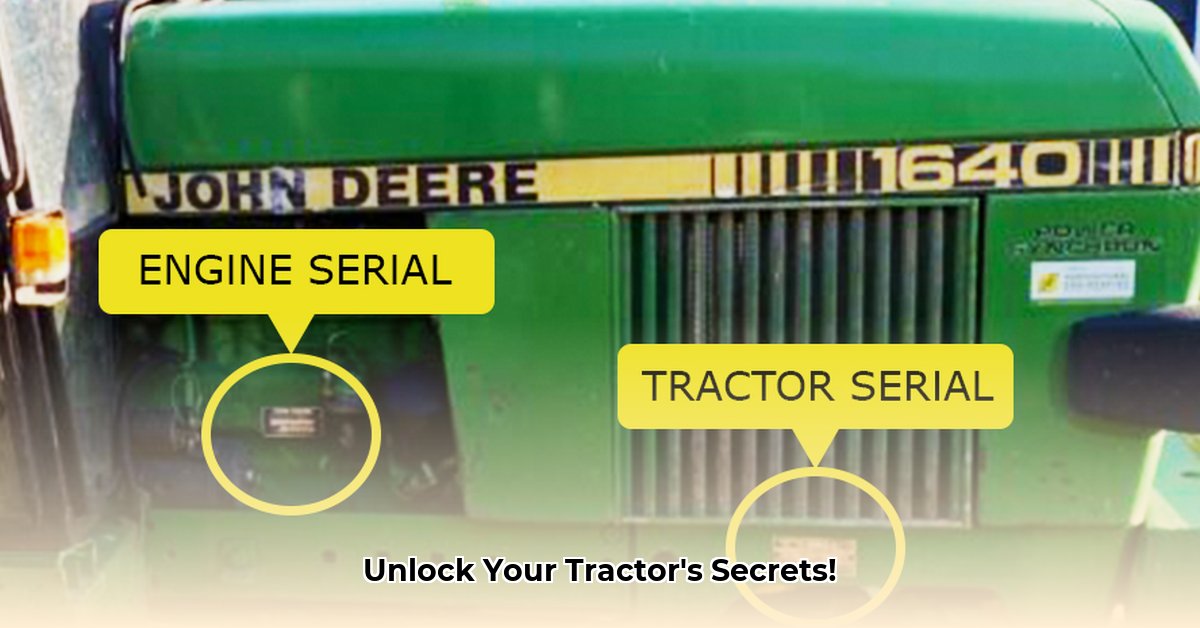
Unearthing Your Tractor's Past: A Guide to John Deere Serial Numbers
Ever wondered about the cryptic numbers and letters stamped on your John Deere tractor's serial plate? It's more than just a random identifier; it's a historical record, a concise summary of your tractor's manufacturing details. This guide will equip you with the knowledge to locate, decipher, and ultimately utilize this invaluable information. Understanding your tractor's serial number is crucial for maintenance, parts ordering, and even assessing its resale value. Let's delve into the fascinating history encoded within those seemingly random characters. For additional help, check out this helpful resource: Find your tractor.
A Journey Through Time: The Evolution of John Deere Serial Numbers
John Deere's serial numbering system has changed significantly over the decades, mirroring the evolution of their tractors themselves. Early models (generally pre-1970s) often featured simpler, less detailed serial numbers – providing basic information like the manufacturing year and possibly the plant of origin. Think of these as brief telegrams, conveying essential facts without extensive detail. However, as manufacturing processes advanced and John Deere's record-keeping became more sophisticated, so did their serial numbers.
Post-1970s tractors boast far more complex serial numbers, providing a wealth of information – a detailed letter from the past. These detailed identifiers often include the manufacturing year, model, factory code, and even a sequential production number, providing a much richer understanding of your tractor's origins. This detailed information is crucial for ordering the correct parts, ensuring accurate maintenance scheduling, and even assessing your tractor's resale value. The change reflects a significant shift in manufacturing and record-keeping practices at John Deere. Have you ever considered how this evolution parallels the advancement of tractor technology itself?
Locating the Serial Number Plate: Your First Step
Before we decode the secrets hidden within your tractor's serial number, we must first locate it! The serial number is typically stamped on a metal plate affixed to the tractor's frame. Common locations include near the engine block, on the right-hand side of the chassis, or even under a panel. A flashlight and a little detective work may be necessary, as these plates can sometimes be obscured by dust, grime, or simply hidden from plain view. Sometimes, a little cleaning is all it takes to reveal these hidden treasures! Remember to take a high-quality photograph of the plate for easy reference.
Decoding the Serial Number: Unlocking Your Tractor's History
The method for deciphering your tractor's serial number depends largely on its age and the corresponding numbering system used during its manufacture.
Older Tractors (Generally Pre-1970s): The Concise Messages
Older John Deere tractors often possess shorter serial numbers, offering a glimpse into their manufacturing history. While less detailed than their post-1970s counterparts, this information can still provide valuable insights. You might be able to determine the manufacturing year and potentially the factory of origin, offering a direct connection to John Deere's rich manufacturing past. Online forums and historical records may provide supplemental information for interpretation.
Newer Tractors (Generally Post-1970s): The Detailed Chronicles
Post-1970s John Deere tractors typically boast much longer and more complex serial numbers. These numbers are veritable treasure troves of information, often revealing the manufacturing year, model number, factory code, and a sequential production number unique to that specific tractor. For instance, a typical serial number might resemble this (although the format and meaning of individual parts vary from model to model): "ABCDEF1234567".
- ABC: Model series designator.
- DEF: Factory code (Waterloo, Dubuque, etc.).
- 1234567: Series Production number.
A comprehensive table of factory codes specific to your tractor's era is essential to accurate decoding. Many reputable online resources and John Deere enthusiast forums provide such tables; however, confirming information from several reputable sources is always recommended.
Utilizing Decoded Information: Practical Applications
Once you've successfully deciphered your tractor's serial number, you'll possess a wealth of valuable information. This knowledge has practical applications in several critical areas:
Maintenance: Knowing the exact age and model of your tractor enables precise scheduling of routine maintenance, preventing potential breakdowns and extending its lifespan.
Parts Ordering: Accurately identifying your tractor model via the serial number ensures that you obtain the correct replacement parts, improving efficiency and cost-effectiveness.
Resale Value: A well-maintained tractor with a documented history, verifiable through its serial number, generally commands a higher resale value.
Historical Research: Connect with the rich history of your equipment and learn more about its origins!
Troubleshooting: Addressing Common Challenges
Occasionally, you might encounter obstacles in locating or deciphering your tractor's serial number. The plate may be damaged, worn, or even missing. If this is the case, don't despair! Thoroughly clean the area where the plate should be located; often, hidden markings may be revealed. If no luck, consider contacting your local John Deere dealer; they may be able to assist with identifying your tractor based on its other markings and specifications. High-resolution images of any partially visible markings can also be helpful in interpretation.
Leveraging Online Resources: Expanding Your Knowledge
Numerous online resources, forums, and enthusiast communities dedicated to John Deere tractors can provide additional assistance with serial number decoding. These resources often contain detailed guides, factory code lists, and historical information specific to various tractor models. However, it's crucial to use reputable sources and verify information against several sources before making any important decisions based on the data.
Conclusion: Embrace Your Tractor's History
Understanding your John Deere tractor's serial number is far more than a simple technical exercise; it's a journey into the history of your equipment, providing valuable insights and practical knowledge vital for long-term ownership. By mastering this skill, you're not only improving your tractor’s maintenance and longevity but also enriching your connection to its past.